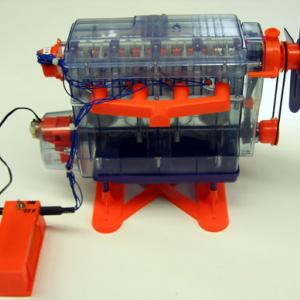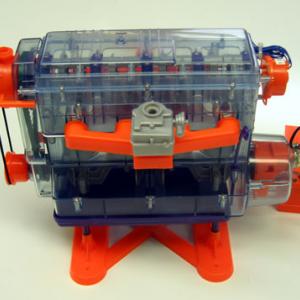College of Liberal Arts & Sciences
4F30.52 - Gas Engine Model
Make sure the batteries in the power module are in good shape. Turn on the power module and observe the engine parts. The moving parts will all be seen to move in correct sequence. In particular, note the movement of the valves, pushrods, camshaft, piston, and crankshaft. The firing order is shown by the LED's that serve as spark plugs.
- Dwight E. Neuenschwander, "Engine Cadaver Lab: Hands-On Physics That Kicks Back", TPT, Vol. 58, #8, Nov. 2020, p. 536.
- Thomas B. Greenslade, Jr., "Gasoline Engine Half Model (Photo)", AJP, Vol. 72, # 9, Sept. 2004, p. 1261.
- Thomas B. Greenslade, Jr., "Four Cylinder Gasoline Engine Model (Photo)", AJP, Vol. 72, # 9, Sept. 2004, p. 1240.
- Dawn K. Manley, Andrew McIlroy, Craig A. Taatjes, "Research Needs for Future Internal Combustion Engines", Physics Today, Nov. 2008, p. 47.
- "Smithsonian Motor-Works", #90804. Smithsonian Institution - Natural Science Industries, Ltd. 2001.
- Revell, "How an Auto Engine Works", Kit 8883.
Disclaimer: These demonstrations are provided only for illustrative use by persons affiliated with The University of Iowa and only under the direction of a trained instructor or physicist. The University of Iowa is not responsible for demonstrations performed by those using their own equipment or who choose to use this reference material for their own purpose. The demonstrations included here are within the public domain and can be found in materials contained in libraries, bookstores, and through electronic sources. Performing all or any portion of any of these demonstrations, with or without revisions not depicted here entails inherent risks. These risks include, without limitation, bodily injury (and possibly death), including risks to health that may be temporary or permanent and that may exacerbate a pre-existing medical condition; and property loss or damage. Anyone performing any part of these demonstrations, even with revisions, knowingly and voluntarily assumes all risks associated with them.

